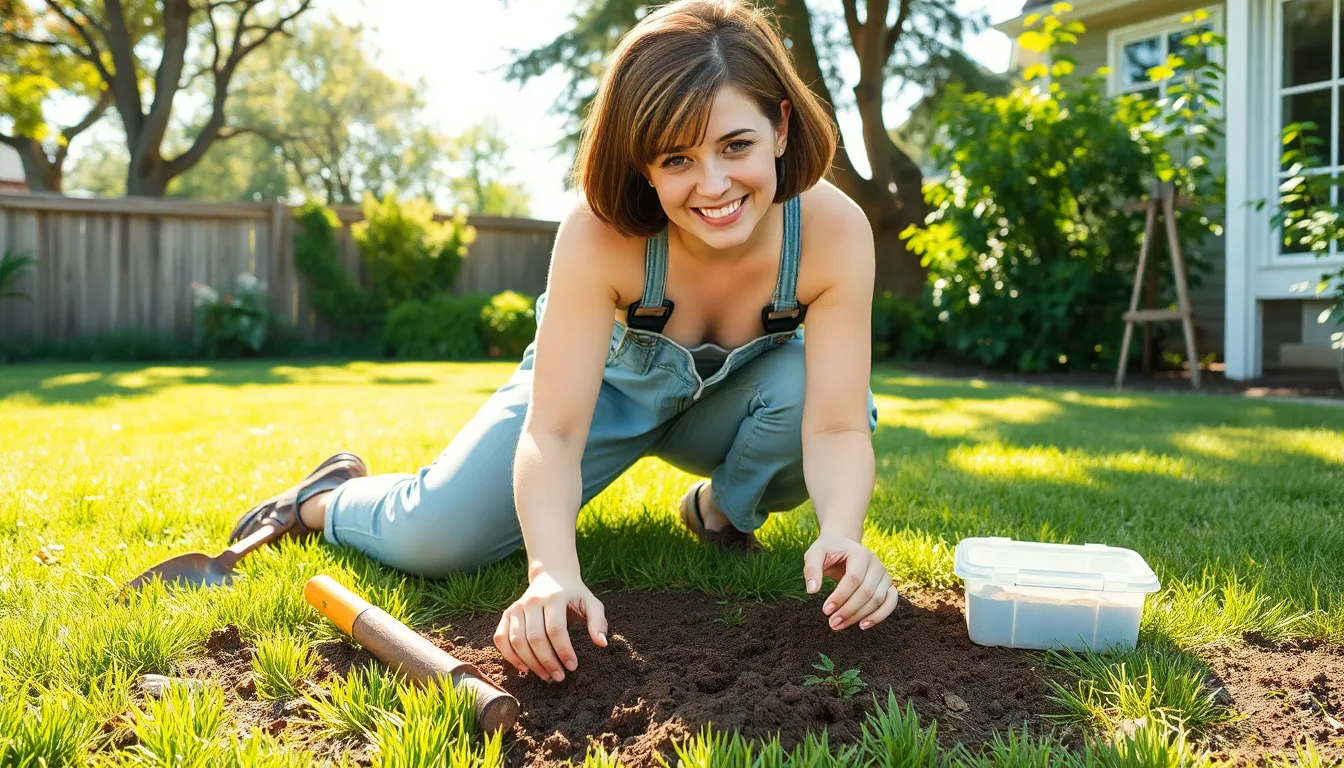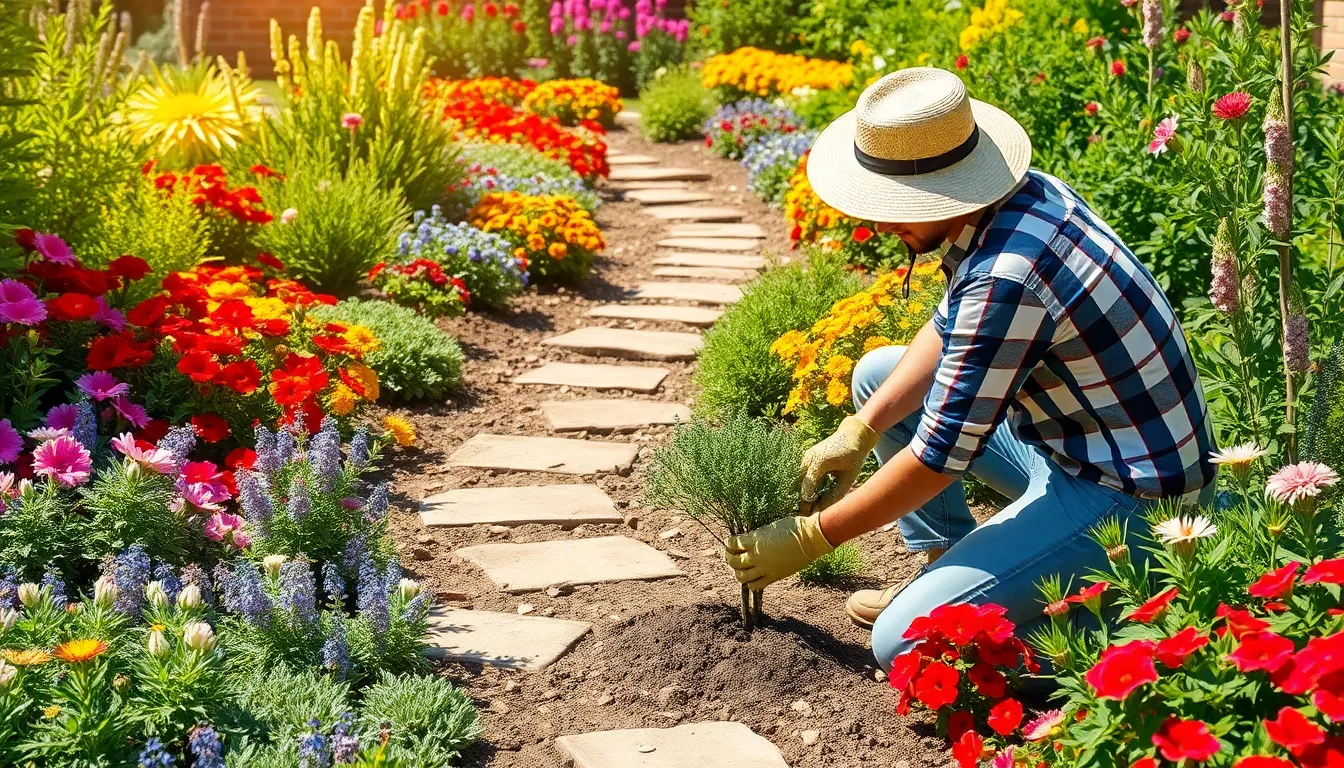Designing a garden isn’t just about planting a few flowers and hoping for the best. It’s an art form that transforms a patch of dirt into a vibrant oasis. Imagine stepping outside to a lush paradise that not only pleases the eye but also makes your neighbors green with envy. Who wouldn’t want that?
How to Design a Garden
Creating a garden involves thoughtful design principles that transform spaces. Understanding these principles helps gardeners establish balanced, attractive environments.
Importance of Planning
Planning a garden sets the foundation for success. Determining the location and purpose of the garden helps guide decisions on plant selection, layout and features. Considering sunlight, soil type and climate ensures appropriate choices are made. Gardeners benefit from sketching layouts to visualize the design. Prioritizing functionality and aesthetics leads to a harmonious balance in plants and structures. Effective planning reduces potential problems and encourages a rewarding gardening experience.
Key Elements of Garden Design
Focusing on key elements enhances the overall design. Color plays a critical role, with various hues creating mood and harmony. Texture contributes visual interest, using different plant types to achieve dynamic contrasts. Scale and proportion determine how each element interacts within the space. Lines guide movement and focus, whether through pathways or plant arrangements. Unity brings coherence to the design, emphasizing the connection between each component. Incorporating these elements creates a captivating and inviting garden that resonates with both form and function.
Assessing Your Space

Assessing the garden space involves evaluating essential factors for successful design. It guides effective plant selection and layout.
Evaluating Sunlight and Shade
Sunlight significantly influences plant growth. Observe sunlight patterns throughout the day. Identify areas that receive full sun, partial shade, or full shade. For example, some plants thrive in direct sunlight, while others prefer shaded areas. Take care to place sun-loving plants where they receive at least six hours of sunlight daily. Also, consider how nearby trees and structures create shade. Noting these aspects ensures that plants receive appropriate light for optimal growth.
Analyzing Soil and Drainage
Soil quality serves as the foundation for plant health. Begin by testing soil type. Sandy soil drains quickly, while clay soil retains moisture. Conducting a drainage test can reveal how well your soil absorbs water. Additionally, consider the soil pH levels, as they affect nutrient availability. Incorporating organic matter improves soil structure and fertility. Proper drainage prevents waterlogging, which can harm plant roots. Understanding these elements fosters a thriving garden environment.
Choosing a Garden Style
Selecting a garden style significantly influences the overall aesthetic and functionality. Consider personal preferences alongside the space’s natural characteristics when making this choice.
Modern Garden Design
Modern garden design emphasizes clean lines and minimalistic approaches. Incorporating geometric shapes with a focus on symmetry helps create a contemporary look. Hardscaping materials, such as concrete and steel, often take center stage. Plant selection typically features low-maintenance, drought-resistant varieties. The use of bold, contrasting colors enhances visual interest while keeping a sophisticated balance.
Cottage Garden Design
Cottage garden design embraces a relaxed, informal style bursting with character. This approach showcases a diverse mix of flowers, herbs, and vegetables, creating a charmingly chaotic appearance. Climbing plants, like roses and clematis, add vertical interest to traditional fences. Organic shapes in pathways, garden beds, and furniture often reflect a whimsical feel. Emphasizing a connection to nature, this design encourages biodiversity and attracts beneficial insects.
Zen Garden Design
Zen garden design reflects tranquility and simplicity, focusing on minimalism. Raked gravel or sand represents water, symbolizing serenity and calm. Elemental features, like rocks, boulders, and carefully placed plants, guide the observer’s eye and promote mindfulness. Bamboo fences and stone lanterns enhance the serene atmosphere while creating defined spaces. Incorporating evergreens offers year-round interest, helping maintain balance within this peaceful environment.
Selecting Plants and Materials
Choosing the right plants and materials shapes the garden’s overall look and functionality. Thoughtful selection enhances both aesthetics and sustainability.
Plant Types and Their Requirements
Different plant types thrive under specific conditions. Annuals, for instance, provide vibrant colors but require full sunlight and regular watering. Perennials, in contrast, return each year, adapting well to various soil types. Shade-loving plants, like ferns, flourish in lower light conditions. Drought-tolerant options, such as succulents, minimize water requirements and offer unique textures. Herbs, combined with ornamental plants, add fragrance and utility. Each plant type contributes to a well-rounded garden based on the climate and soil conditions.
Hardscaping Materials
Selecting appropriate hardscaping materials plays a crucial role in garden design. Natural stone provides durability and complements garden aesthetics. Concrete offers versatility and can be molded into various shapes for pathways and patios. Wood, both functional and aesthetic, enhances rustic charm and provides warmth. Metal elements, such as steel or aluminum, introduce modern touches and resist weathering. Gravel pathways create easy drainage while adding texture. Each material works together to define spaces and support the garden’s overall theme.
Creating a Garden Layout
Creating an effective garden layout involves careful planning and creativity. A well-considered plan enhances aesthetic appeal and ensures functionality.
Sketching Your Garden Plan
Sketching a garden plan starts with measuring the space accurately. Include existing features like trees, pathways, and fences. By identifying sun and shade areas, it becomes easier to determine the best locations for plants. Design concepts should account for pathways that allow access without overcrowding the garden. Consider highlighting different zones for various plant types, helping to visualize relationships between elements.
Incorporating Focal Points
Incorporating focal points captures attention and adds interest. These can range from a striking sculpture to an impressive tree or a vibrant flower bed. Position focal points strategically, ensuring they draw the eye while complementing the overall design. Placement should consider sightlines from seating areas or pathways, enhancing the experience for visitors. Utilize height and texture variations to enrich the visual appeal and create depth within the garden layout.
Maintaining Your Garden
Maintaining a garden involves ongoing care that ensures vibrant growth and seasonal beauty. Essential tasks like watering, fertilizing, and pruning help keep plants healthy and thriving.
Seasonal Care Tips
Spring marks the beginning of garden rejuvenation. Gardeners often focus on preparing soil and planting new seeds. Summer duties may include regular watering and deadheading flowers for continuous blooms. In autumn, it’s time to prune and prepare plants for dormancy. Winter maintenance focuses on protecting sensitive plants from harsh weather; mulching can provide necessary insulation. Following a seasonal care schedule fosters a flourishing garden year-round.
Pest Management Strategies
Effective pest management keeps gardens healthy and vibrant. Regular inspections help identify pests early, allowing for targeted intervention. Organic solutions like introducing beneficial insects effectively control pest populations. Neem oil and insecticidal soaps serve as eco-friendly alternatives for treating infestations. Another strategy involves rotating crops to disrupt pest life cycles. By combining these tactics, gardeners minimize damage while promoting a balanced ecosystem.
Conclusion
Designing a garden is a rewarding journey that combines creativity and practicality. By understanding the essential principles of garden design and carefully considering factors like location and soil type, anyone can create a stunning outdoor space.
Selecting the right plants and materials plays a vital role in achieving a harmonious balance between beauty and functionality. With thoughtful planning and ongoing maintenance, a garden can thrive and evolve with the seasons.
Ultimately, the result is not just a collection of plants but a personal sanctuary that brings joy and satisfaction to the gardener and all who visit. Embracing these design elements will lead to a garden that truly reflects individual style and enhances the surrounding environment.

